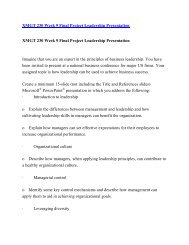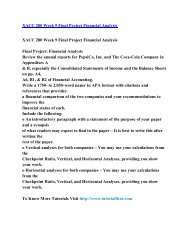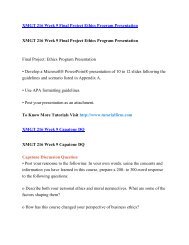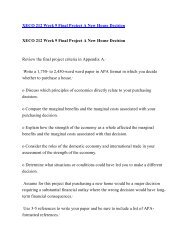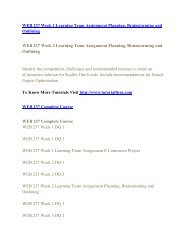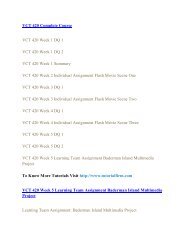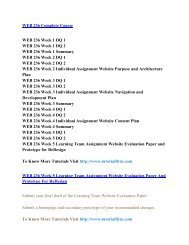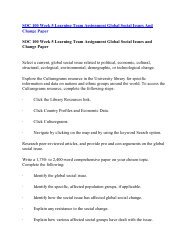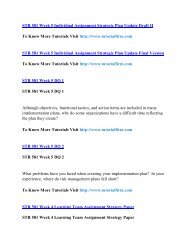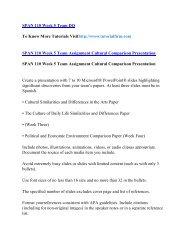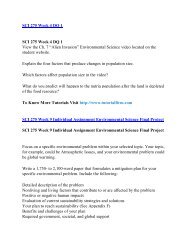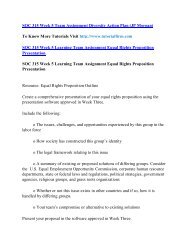QNT 351 UOP Course,QNT 351 UOP Materials,QNT 351 UOP Homework
You also want an ePaper? Increase the reach of your titles
YUMPU automatically turns print PDFs into web optimized ePapers that Google loves.
<strong>QNT</strong> <strong>351</strong> Week 5 Learning Team Assignment Analyzing And Interpreting<br />
Data Set 1 And Set 2<br />
<strong>QNT</strong> <strong>351</strong> Week 5 Learning Team Assignment Analyzing and Interpreting<br />
Data (Attachment Contains PowerPoint Presentation and Papers) Set 1 and<br />
Set 2<br />
Resource: Ballard Integrated Managed Services, Inc., Part 2.<br />
Read the Ballard Integrated Managed Services, Inc., Part 2. Your team acts as a<br />
consultant group that analyzes and interprets this second set of data. The intent is<br />
to increase senior management’s understanding of the sources of employee<br />
dissatisfaction and to create a model that predicts employee resignation.<br />
Combine your Week Two Learning Team assignment and Week Three findings<br />
with Week Five findings and make a recommendation to BIMS.<br />
Use the statistical tables given in the appendices of the textbook and a statistical<br />
analysis application: a Microsoft ® Excel ® spreadsheet, Minitab ® statistical software,<br />
or SPSS software.<br />
Prepare a 1,050- to 1,750-word written report along with a 7- to 9-slide<br />
Microsoft ® PowerPoint ® presentation for the senior management team to present<br />
your findings (see Exhibit D for the data set of the second survey).<br />
To Know More Tutorials Visit http://www.tutorialfirm.com<br />
<strong>QNT</strong> <strong>351</strong> Week 5 DQ 3<br />
<strong>QNT</strong> <strong>351</strong> Week 5 DQ 3<br />
What type of data is best described using a Time Series? Think of an example from<br />
your work place or from your day to day experience.
To Know More Tutorials Visit http://www.tutorialfirm.com<br />
<strong>QNT</strong> <strong>351</strong> Week 5 DQ 2<br />
<strong>QNT</strong> <strong>351</strong> Week 5 DQ 2<br />
In what way has the learning from this course helped you to effectively test<br />
hypotheses, draw conclusions, and provide recommendations to management?<br />
Consider what you have achieved in your research study conducted for this course.<br />
To Know More Tutorials Visit http://www.tutorialfirm.com<br />
<strong>QNT</strong> <strong>351</strong> Week 5 DQ 1<br />
<strong>QNT</strong> <strong>351</strong> Week 5 DQ 1<br />
How do you know you have validated a research study based on data gathered<br />
from primary or secondary sources? Have you been involved with any product<br />
test-marketing project? Explain. How did the resulting statistics affect the<br />
product’s marketing strategy? How can organizations skew the statistical outcomes<br />
of their business research?<br />
To Know More Tutorials Visit http://www.tutorialfirm.com<br />
<strong>QNT</strong> <strong>351</strong> Week 4 Learning Team Assignment Reflection Set 1 And Set 2Q<br />
<strong>QNT</strong> <strong>351</strong> Week 4 Learning Team Assignment Reflection Set 1 and Set 2<br />
Discuss the following with your Learning Team:
· The steps in testing a research hypothesis<br />
· Comparing the means of two or more groups<br />
· Calculating the correlation between two variables<br />
Include the topics you feel comfortable with, any topics you struggled with, and<br />
how the weekly topics relate to application in your field.<br />
Prepare a 350- to 1,050-word paper detailing the findings of your discussion.<br />
To Know More Tutorials Visit http://www.tutorialfirm.com<br />
<strong>QNT</strong> <strong>351</strong> Week 4 DQ 4<br />
<strong>QNT</strong> <strong>351</strong> Week 4 DQ 4<br />
Think of an example of the use of one sample hypothesis testing at your<br />
workplace. How will you state the hypothesis as a Null and the Alternative<br />
hypothesis?<br />
To Know More Tutorials Visit http://www.tutorialfirm.com<br />
<strong>QNT</strong> <strong>351</strong> Week 4 DQ 3<br />
<strong>QNT</strong> <strong>351</strong> Week 4 DQ 3<br />
What are the key terms in a verbal hypothesis that signify whether you are<br />
conducting a one–tailed or two-tailed test? Explain with an example and also state<br />
the Null and the Alternative hypothesis for the example in symbolic form.
To Know More Tutorials Visit http://www.tutorialfirm.com<br />
<strong>QNT</strong> <strong>351</strong> Week 4 DQ 2<br />
<strong>QNT</strong> <strong>351</strong> Week 4 DQ 2<br />
Under what conditions would you use a t-test as opposed to a z-test? Can you use<br />
the t-table to determine the critical value of the z-test? Explain why. What are the<br />
differences between a one-tailed and a two-tailed test?<br />
To Know More Tutorials Visit http://www.tutorialfirm.com<br />
<strong>QNT</strong> <strong>351</strong> Week 4 DQ 1<br />
<strong>QNT</strong> <strong>351</strong> Week 4 DQ 1<br />
What are the five steps in the hypothesis testing procedure? Are the steps followed<br />
in sequence? Explain why or why not. How does the five-step procedure for<br />
hypothesis testing differ when comparing two groups using a t- or z-test? How is<br />
the process similar?<br />
To Know More Tutorials Visit http://www.tutorialfirm.com<br />
<strong>QNT</strong> <strong>351</strong> Week 3 Learning Team Assignment Summarizing And Presenting<br />
Data Set 1 And Set 2<br />
<strong>QNT</strong> <strong>351</strong> Week 3 Learning Team Assignment Summarizing and Presenting<br />
Data Set 1 and Set 2<br />
Prepare a 1,050- to 1,750-word report of conclusions drawn from the data and<br />
make recommendations to the management.
Support recommendations by citing literature consistent with APA guidelines.<br />
If using the Ballard Integrated Managed Services, Inc., (BIMS) case study<br />
overview:<br />
Revise the report submitted in Week Two based on the feedback provided by the<br />
instructor in the Learning Team assignment, and insight gained by reading.<br />
Analyze the data included in BIMS case study Part 1 by computing descriptive<br />
statistics in the form of tables, charts, measures of central tendency, and variability.<br />
Prepare a 1,050- to 1,750-word report of conclusions drawn from the data and<br />
make recommendations to the management.<br />
Support recommendations by citing literature consistent with APA guidelines.<br />
To Know More Tutorials Visit http://www.tutorialfirm.com<br />
<strong>QNT</strong> <strong>351</strong> Week 3 DQ 5<br />
<strong>QNT</strong> <strong>351</strong> Week 3 DQ 5<br />
What are the characteristics of standard normal distribution? The HR department<br />
of an organization collects data on employees’ age, salary, level of education,<br />
gender, and ethnicity. Which data do you think is more likely to follow normal<br />
distribution? Explain why.<br />
To Know More Tutorials Visit http://www.tutorialfirm.com<br />
<strong>QNT</strong> <strong>351</strong> Week 3 DQ 4<br />
<strong>QNT</strong> <strong>351</strong> Week 3 DQ 4
Provide an example of a discrete data in your work situation that at least<br />
approximately obeys the four characteristics of the Binomial distribution.<br />
To Know More Tutorials Visit http://www.tutorialfirm.com<br />
<strong>QNT</strong> <strong>351</strong> Week 3 DQ 3<br />
<strong>QNT</strong> <strong>351</strong> Week 3 DQ 3<br />
What is the role of probability concepts in business decision-making? Explain<br />
using a specific example.<br />
To Know More Tutorials Visit http://www.tutorialfirm.com<br />
<strong>QNT</strong> <strong>351</strong> Week 3 DQ 2<br />
<strong>QNT</strong> <strong>351</strong> Week 3 DQ 2<br />
What are some conditions under which business decisions are made using<br />
subjective probability concepts? Provide at least two examples of subjective<br />
probability.<br />
To Know More Tutorials Visit http://www.tutorialfirm.com<br />
<strong>QNT</strong> <strong>351</strong> Week 3 DQ 1<br />
<strong>QNT</strong> <strong>351</strong> Week 3 DQ 1<br />
What are the differences between probability and coincidence? Can the probability<br />
be more than 1 or less than 0? Explain why or why not.<br />
To Know More Tutorials Visit http://www.tutorialfirm.com
<strong>QNT</strong> <strong>351</strong> Week 2 Learning Team Assignment Data Collection Set 1 And Set 2<br />
<strong>QNT</strong> <strong>351</strong> Week 2 Learning Team Assignment Data Collection (Attachments<br />
Includes Power Point Presentation And Paper) Set 1 and Set 2<br />
Resources: Ballard Integrated Managed Services, Inc., Part 1<br />
Review the Ballard Integrated Managed Services, Inc. (BIMS), Part 1 case study<br />
overview.<br />
Prepare a 700- to 1,050-word written report along with a 5- to 7-slide<br />
Microsoft ® PowerPoint ® presentation for the senior management team to present<br />
your findings (see Exhibit D for the data set of the second survey).<br />
Address the following:<br />
1. · Present the BIMS situation as an overview—problem, purpose,<br />
research questions, and hypotheses.<br />
2. · Describe the instrument used for data collection.<br />
3. · Identify types of data collected—quantitative, qualitative, or both—and<br />
how the data is collected.<br />
4. · Identify the level of measurement for each of the variables involved in<br />
the study.<br />
5. · Code the data if you have not done so. Describe how the data is coded<br />
and evaluate the procedure used.<br />
6. · Clean the data by eliminating the data input errors made.<br />
· Draw conclusions about appropriateness of the data to meet the purpose of<br />
the study.<br />
To Know More Tutorials Visit http://www.tutorialfirm.com<br />
<strong>QNT</strong> <strong>351</strong> Week 2 DQ 4<br />
<strong>QNT</strong> <strong>351</strong> Week 2 DQ 4
Why it is important to find the shape of data distribution before computing<br />
descriptive statistics? Do all variables follow normal distribution? Explain why or<br />
why not. Explain with examples.<br />
To Know More Tutorials Visit http://www.tutorialfirm.com<br />
<strong>QNT</strong> <strong>351</strong> Week 2 DQ 3<br />
<strong>QNT</strong> <strong>351</strong> Week 2 DQ 3<br />
Select four variables, other that what your fellow students have already selected,<br />
that could be measured by nominal, ordinal, interval, and ratio scale. Classify them<br />
by measurement scale and select descriptive statistics that can be used to<br />
summarize data. Use following table when posting your response:<br />
To Know More Tutorials Visit http://www.tutorialfirm.com<br />
<strong>QNT</strong> <strong>351</strong> Week 2 DQ 2<br />
<strong>QNT</strong> <strong>351</strong> Week 2 DQ 2<br />
Can mean, median, or mode be calculated from all statistical data? Explain why or<br />
why not. When is the mean the best measure of central tendency? When is the<br />
median the best measure of central tendency?<br />
To Know More Tutorials Visit http://www.tutorialfirm.com<br />
<strong>QNT</strong> <strong>351</strong> Week 2 DQ 1<br />
<strong>QNT</strong> <strong>351</strong> Week 2 DQ 1
Describe a business situation, other than what has already been selected by<br />
fellow students or selected from the team assignment, where mean and<br />
standard deviation can be used in decision making. Describe how calculation<br />
of mean and standard deviation can help in making a decision.<br />
To Know More Tutorials Visit http://www.tutorialfirm.com<br />
<strong>QNT</strong> <strong>351</strong> Week 1 Individual Assignment Statistics In Business<br />
<strong>QNT</strong> <strong>351</strong> Week 1 Individual Assignment Statistics in Business<br />
Write a 300-word summary that addresses the following criteria:<br />
1. · Define statistics.<br />
2. · Identify different types and levels of statistics.<br />
3. · Describe the role of statistics in business decision making.<br />
4. . Provide at least three examples or problem situations in which statistics<br />
was used or could be used.<br />
To Know More Tutorials Visit http://www.tutorialfirm.com<br />
<strong>QNT</strong> <strong>351</strong> Week 1 DQ 5<br />
<strong>QNT</strong> <strong>351</strong> Week 1 DQ 5<br />
What are the four data measurement scales? Explain with examples.<br />
To Know More Tutorials Visit http://www.tutorialfirm.com<br />
<strong>QNT</strong> <strong>351</strong> Week 1 DQ 4<br />
<strong>QNT</strong> <strong>351</strong> Week 1 DQ 4
How do you select measurement levels when developing a survey or data<br />
collection tool? Explain with examples.<br />
To Know More Tutorials Visit http://www.tutorialfirm.com<br />
<strong>QNT</strong> <strong>351</strong> Week 1 DQ 3<br />
<strong>QNT</strong> <strong>351</strong> Week 1 DQ 3<br />
How would you define dependent and independent variables? What is their<br />
significance in research? Explain with examples.<br />
To Know More Tutorials Visit http://www.tutorialfirm.com<br />
<strong>QNT</strong> <strong>351</strong> Week 1 DQ 2<br />
<strong>QNT</strong> <strong>351</strong> Week 1 DQ 2<br />
What is the importance of statistics in business decision making? Describe a<br />
business situation where statistics was used in making a decision.<br />
To Know More Tutorials Visit http://www.tutorialfirm.com<br />
<strong>QNT</strong> <strong>351</strong> Week 1 DQ 1<br />
<strong>QNT</strong> <strong>351</strong> Week 1 DQ 1How would you define statistics? How is statistics used<br />
in business decision making?<br />
To Know More Tutorials Visit http://www.tutorialfirm.com
<strong>QNT</strong> <strong>351</strong> Complete <strong>Course</strong><br />
<strong>QNT</strong> <strong>351</strong> Complete <strong>Course</strong><br />
<strong>QNT</strong> <strong>351</strong> Week 1 DQ 1<br />
<strong>QNT</strong> <strong>351</strong> Week 1 DQ 2<br />
<strong>QNT</strong> <strong>351</strong> Week 1 DQ 3<br />
<strong>QNT</strong> <strong>351</strong> Week 1 DQ 4<br />
<strong>QNT</strong> <strong>351</strong> Week 1 DQ 5<br />
<strong>QNT</strong> <strong>351</strong> Week 1 Individual Statistics in Business<br />
<strong>QNT</strong> <strong>351</strong> Week 2 DQ 1
<strong>QNT</strong> <strong>351</strong> Week 2 DQ 2<br />
<strong>QNT</strong> <strong>351</strong> Week 2 DQ 3<br />
<strong>QNT</strong> <strong>351</strong> Week 2 DQ 4<br />
<strong>QNT</strong> <strong>351</strong> Week 2 Learning Team Data Collection (Attachments Includes Power<br />
Point Presentation And Paper)<br />
<strong>QNT</strong> <strong>351</strong> Week 3 DQ 1<br />
<strong>QNT</strong> <strong>351</strong> Week 3 DQ 2<br />
<strong>QNT</strong> <strong>351</strong> Week 3 DQ 3<br />
<strong>QNT</strong> <strong>351</strong> Week 3 DQ 4<br />
<strong>QNT</strong> <strong>351</strong> Week 3 DQ 5
<strong>QNT</strong> <strong>351</strong> Week 3 Learning Team Summarizing and Presenting Data<br />
<strong>QNT</strong> <strong>351</strong> Week 4 DQ 1<br />
<strong>QNT</strong> <strong>351</strong> Week 4 DQ 2<br />
<strong>QNT</strong> <strong>351</strong> Week 4 DQ 3<br />
<strong>QNT</strong> <strong>351</strong> Week 4 DQ 4<br />
<strong>QNT</strong> <strong>351</strong> Week 4 Learning Team Reflection<br />
<strong>QNT</strong> <strong>351</strong> Week 5 DQ 1<br />
<strong>QNT</strong> <strong>351</strong> Week 5 DQ 2
<strong>QNT</strong> <strong>351</strong> Week 5 DQ 3<br />
<strong>QNT</strong> <strong>351</strong> Week 5 Learning Team Analyzing and Interpreting Data (Attachment<br />
Contains PowerPoint Presentation and Papers)<br />
To Know More Tutorials Visit http://www.tutorialfirm.com




